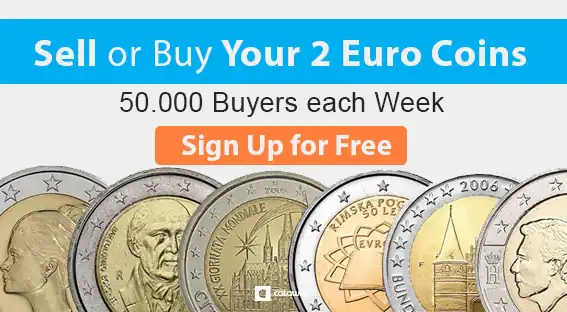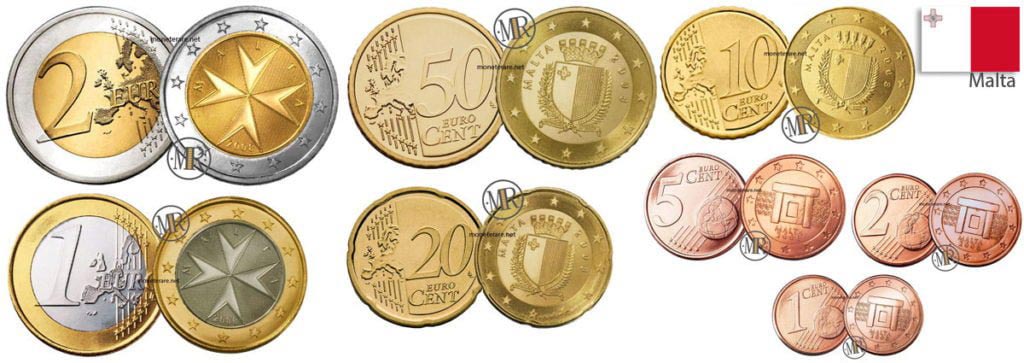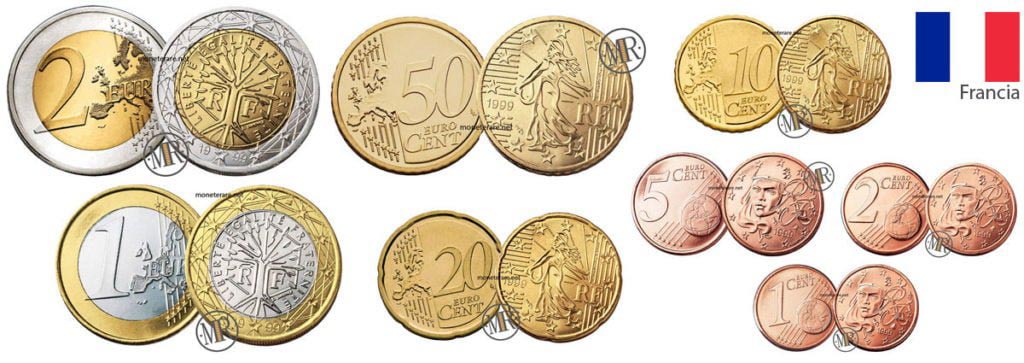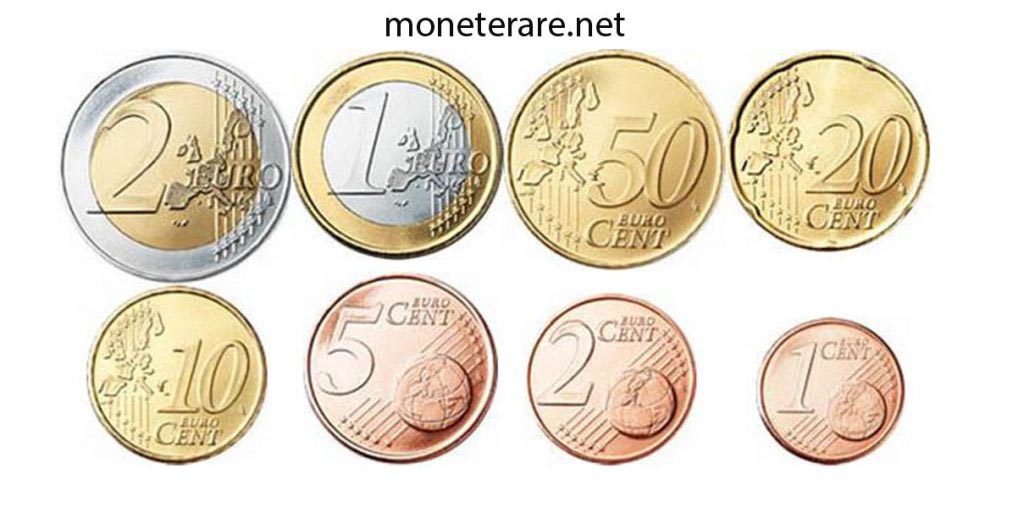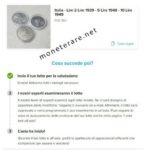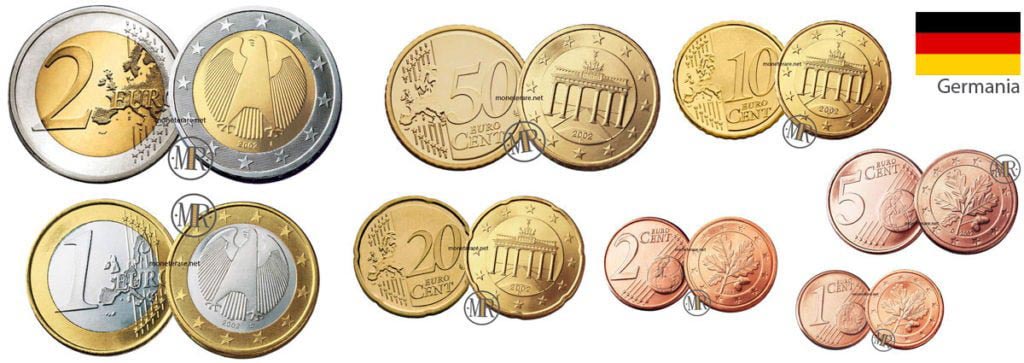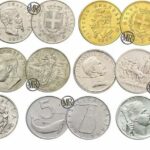Today’s trip will be a journey to discover Estonian Numismatics and Euro Estonia Coins. In particular, before going to see in detail every single Estonian Euro coins, it is important to analyze what is the history of the currency of this country.

Storia della Numismatica estone
The historical currency of Estonia, at least in recent years, has been the Kroon or Corona (crown). However, the same currency has seen two distinct and separate periods: the ‘first Kroon period’ and the ‘second Kroon period’.
The first Kroon period began in 1928 when the crown was introduced to replace the Estonian Mark the coin in circulation before then. Specifically, the fixed exchange rate was 100 Estonian marks = 1 kroon.
It remained in circulation until 1940, when the USSR invaded the country. From that moment on, the Soviet rouble was declared the main currency with an exchange rate of 1 rouble = 0.8 kroon.
The second Kroon period began in 1992. In that year, in fact, the kroon was introduced again at the expense of the Soviet rouble, which since 1940 had been the official currency. This time the exchange rate was fixed at 1 kroon = 10 roubles.
Since 28 June 2004 Estonia has been a member of the EU and since then work has been done on the introduction of the Single Currency.
Specifically, the final changeover took place on 1 January 2011 with an exchange rate of 1 Euro = 15.6466 crowns.
Estonia was the 17th country to adopt the euro.
After having made this brief but necessary introduction, we now move on to the analysis of the different Estonian euro coins. In the course of this article we will discover characteristics, measures and particularities.
Let’s see them together.
1 cent Estonian euro coins
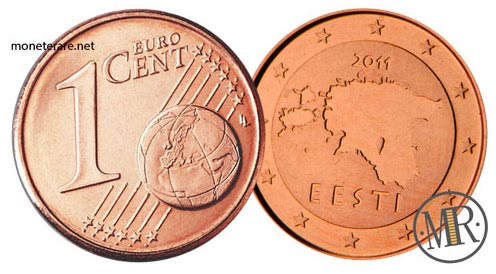
The first euro coin that we are going to analyse is, of course, the 1 euro cent coin from Estonia. Specifically, this coin was created by the author Lembit Lohmus.
At the obverse we can immediately notice the representation of the map of Estonia. At the top is placed the thousandth of minting while at the bottom is the inscription “EESTI” which means precisely ESTONIA.
All around are the 12 five-pointed stars that represent the countries of the European Union.
On the reverse side, the coin has the same face as the other coins with the representation of Europe in the world.
But let’s also see the technical characteristics of this coin.
- Materials: The material used for this coin is steel plated with copper (steel 94.35% – copper 5.65%).
- Thickness: The thickness is equal to 1.67 mm
- Weight: The weight is equal to 2.30 grams
- Diameter: The diameter is 16.25 mm
- Outline: The contour is completely smooth
- Engraver: Lembit Lohmus
Value and Circulation of 1 Cent Estonian Euro Coins
Here is the table with the circulations and their values:
2 Cents Estonian euro coins
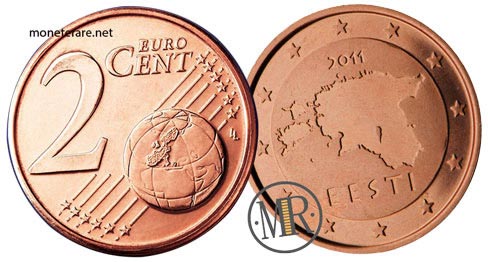
Let us move on to the next coin, the 2 cent euro coin of Estonia. Also in this case the author is always the same or Lembit Lohmus.
In the Obverse we find also in this case the representation of the map of Estonia. Above you can see the thousandth of minting while immediately below the words “EESTI” which means “Estonia”.
All around you can see the classic 12- star five-pointed representing the European states.
On the reverse we can find the same face on the other European 2-cent coins.
But let’s see immediately what are the technical characteristics of this coin.
- Materials: Also in this case the material used is steel plated with copper (steel 94.35% – copper 5.65%).
- Thickness: The thickness is equal to 1.67 mm
- Weight: Weight increases to 3.06 grams
- Diameter: The diameter is 18.75 mm
- Outline: The contour is characterized by an incused horizontal thread
- Engraver: Lembit Lohmus
Value and Circulation of 2 Cents Estonian Euro Coins
Below are the values and runs of the 2-cent coins, divided by years:
5 cents Estonian euro coins
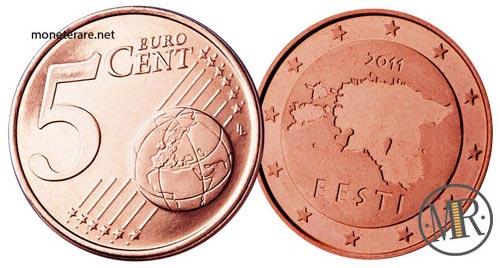
So let’s get to the next currency, the 5 cents Estonian euro coins. Also for this coin the author is the same that is Lembit Lohmus..
In the Obverse we find the representation of Estonia with its borders and the perfect map. At the top there is instead the thousandth of minting while at the bottom you can read the words “EESTI” which in Estonian means precisely “ESTONIA”.
All around the design are the 12 five-pointed stars representing the European States.
While on the reverse we can see the same face on virtually any European 5-cent coin.
But let’s also see the technical characteristics of this coin.
- Materials: Once again the material is steel plated with copper, 94.35% of which is steel and 5.65% copper.
- Thickness: The thickness is still 1.67 mm
- Weight: Weight increases further to 3.90 grams
- Diameter: The diameter also increases to 21.25 mm
- Outline: The contour returns to being completely smooth
- Engraver: Lembit Lohmus
Value and Circulation of 5 Cents Estonian Euro Coins
Here’s year by year all values for the 5 cent Estonian euro coins:
10 cents Estonian euro coins
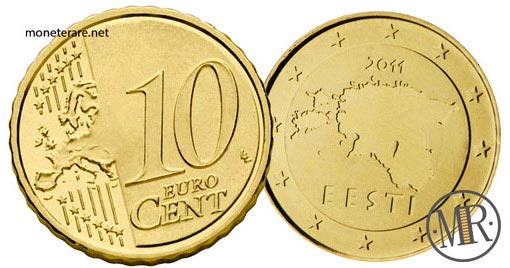
We have arrived at the 10 cents Euro Estonia coin. This means that we are at the fourth coin and perfectly in the middle of our journey. The author of this coin is also Lembit Lohmus.
At the obverse we can immediately notice the representation of Estonia with the thousandth of minting at the top. Below is the inscription “EESTI” which means precisely “ESTONIA”.
All around, instead, the 12 stars representing the European States have been inserted. On the reverse side we can see that the face is the same as the other 10 cents coins.
What we are interested in, however, are also the technical specifications of this piece.
- Materials: The material used this time is the Nordic Gold consisting of copper for 89% – zinc for 5% – aluminum for 5% – tin for 1%.
- Thickness: The thickness increases to 1.93 mm
- Weight: Weight also increases further to 4.10 grams
- Diameter: The diameter decreases to 19.75 mm.
- Outline: The contour is grooved with thick knurling
- Engraver: Lembit Lohmus
Value and Circulation of 10 Cents Estonian Euro Coins
Circulation and values divided year by year:
20 cents Estonian euro coins
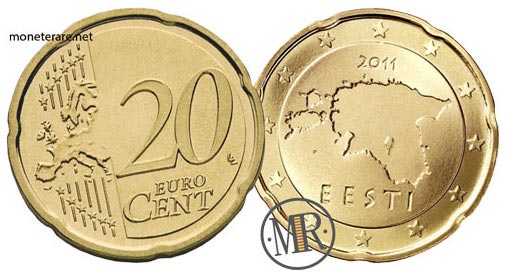
The next coin to be analyzed is the 20-cent Euro Estonia. Also with regard to this specific coin we speak of the same author or Lembit Lohmus.
On the obverse side we can see that the coin has a perfectly imprinted representation of Estonia in the centre. At the top there is the thousandth of minting while at the bottom we can see the inscription “EESTI” which in Estonian means precisely “ESTONIA”..
The 12 five-pointed stars representing the European states surround it all. On the reverse side, the coin has the same face as the other 20 cent European coins.
Let us now turn to the technical characteristics of this coin.
- Materials: Also here the material used is Nordic Gold (copper for 89% – zinc for 5% – aluminium for 5% – tin for 1%).
- Thickness: The thickness increases to 2.14 mm
- Weight: The weight undergoes a major variation reaching up to 5.74 grams
- Diameter: The diameter also increases to 22.25 mm
- Outline: The contour consists of a wide knurling
- Engraver: Lembit Lohmus
Value and Circulation of 20 Cents Estonian Euro Coins
Table divided by years of circulation with values indicated:
50 cents Estonian euro coins
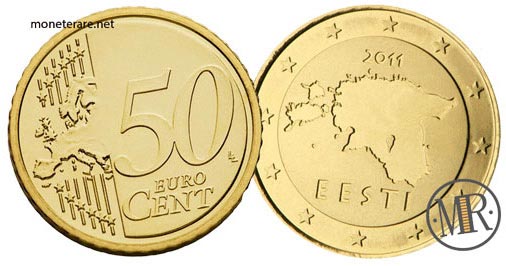
Here we are with the 50 cents Estonian euro coins. Also for this specific coin we always talk about the same author or Lembit Lohmus.
In fact, the coin shows, as always, the representation of Estonia in a perfect central carving. Above the geographical map there is the thousandth of minting while below the inscription “EESTI” which, as in the Estonian language, translates with the name “ESTONIA”.
This design is accompanied all around by the 12 five-pointed stars representing the European states. On the reverse side, however, we can see the same face as the other European coins.
Let’s better analyze together what are the technical characteristics of this coin.
- Materials: Once again the material used is Nordic Gold, 89% copper – 5% zinc – 5% aluminium – 5% tin – 1%.
- Thickness: The thickness increases slightly to 2.38 mm.
- Weight: The weight also increases very significantly to 7.80 grams
- Diameter: A slight increase is also measured for the diameter which reaches 24.25 mm
- Outline: The contour is grooved with thick knurling
- Engraver: Lembit Lohmus
Value and Circulation of 50 Cents Estonian Euro Coins
This is the table with the coins values and the circulation:
1 Euro Estonia Coin
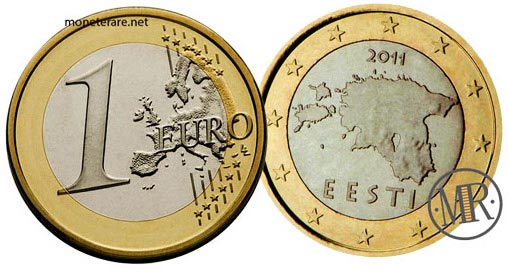
Here we are with the second-to-last coin of this fantastic collection. Specifically, let’s look at the 1 euro coin from Estonia. As for the other coins seen so far, also in this case the author is Lembit Lohmus.
In fact, in the Obverse we can see the same subject, namely the representation of Estonia with its borders and its mapping. At the top there is the thousandth of minting while at the bottom we can see the words “EESTI” which in the local language means “ESTONIA.
All around us we can see the 12 five-pointed stars representing the European states. On the reverse side of the coin, like the other views, it has the same face as the other 1 euro coins with the representation of Europe in the world.
But let’s also see what are the technical characteristics of this coin.
- Materials: As for this coin we are talking about a double material. The external part in fact consists of nickel-brass, that is 75% copper, 20% zinc and 5% nickel. The inner part is instead of copper-nickel or 75% copper and 25% nickel
- Thickness: The thickness decreases slightly to 2.33 mm
- Weight: Even the weight decreases slightly to 7.50 grams
- Diameter: A slight decrease is also measured for the diameter, which reaches 23.25 mm.
- Outline: The contour is striped discontinuously
- Engraver: Lembit Lohmus
Value and Circulation of 1 Euro Coins of Estonia
Table divided by years indicating the values and the quantities:
2 Euro Estonia Coin
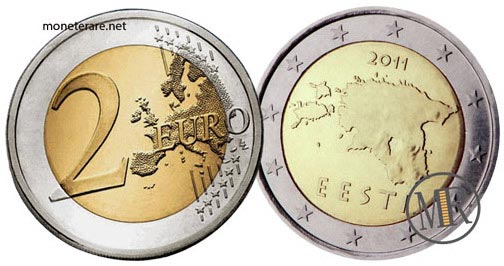
Finally here we are at the last coin of this collection the coin 2 Euro Estonia. Also for this last coin the author is always the same, that is Lembit Lohmus. One important thing: rememeber to have a look at the Estonian commemorative 2 euro coins also. They are different and very interesting.
On the obverse once again is presents the magnificent representation of the Estonian territory. Above we can see the thousandth of minting while below is inserted the words “EESTI” which means precisely “ESTONIA”.
All around the design are instead inserted the usual 12 stars, present on virtually any European coin, which symbolize the European States.
On the reverse side, the coin is the same as all other 2 Euro coins.
We conclude this collection by analysing together the technical characteristics of this specific piece.
- Materials: Also for this coin we speak of a double material. The outer part is nickel brass or 75% copper, 20% zinc and 5% nickel. The inner part is instead in copper-nickel, that is 75% copper and 25% nickel.
- Thickness: The thickness of this coin decreases even further to reach 2.20 mm
- Weight: On the contrary, the weight increases further to 8.50 grams. This is the heaviest coin in the whole collection.
- Diameter: The diameter also increases slightly to 25.25 mm
- Outline: – The contour is finely galvanized with the motif “E-E-S-T-I” which repeats itself upside down. The two inscriptions (the straight one and the upside-down one are interrupted by a star)
- Engraver: Lembit Lohmus
Value and Circulation of 2 Euro Coins of Estonia
- Among the Estonian euro, the 2 euro coin of 2016 is certainly among the Rare Coins with the highest value, about 10 € in BU.
Here is the table with the circulation and the value of the 2 Euro of Estonia divided by years:
Want to see more Eurocollection coins?
- Two pages you can’t miss: 2 Euro Commemorative Coins and Rare Euro Coins
- The precious Vatican euro coins can be seen here and also the San Marino euro coins
- Here you can see the Malta euro coins and here the Cyprus euro coins.
- Euro coins from Germany can be found here and Euro coins from Estonia and Latvia Euro Coins here.
- Euro coins from France can be found here, as well as Euro coins from Austria.
- Also of great interest are the euro coins from Greece and the euro coins of Luxembourg.
- Here you will find Lithuania Euro coins and Andorra Euro coins
- We also talked about Slovenian Euro coins and Slovakia Euro coins.
- Check also Spanish Euro Coins here and Euro Coins of Portugal here.
- The Netherlands euro coins can be found here and the Ireland euro coins here.
- All precious Monaco Euro coins are here and Belgium Euro coins here

